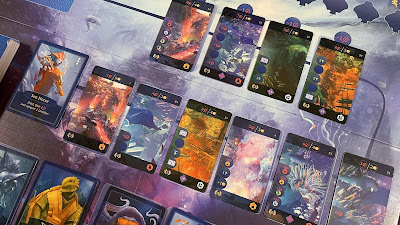WELCOME TO NEW LAS VEGAS
a review of the board game Designed by Alexis Allard and Benoit Turpin
Players: 1-50 Time Investment: 35 min
Rating:
 |
| Sobbing |
Game Aesthetic
Components
Ah, the components section. Well, I'll admit that they're just standard for this game. For those of you who have never played Welcome To before, the game comes with nice player sheets and "normal" cards. No fancy finish or special stock, just "normal". While the rulebook suggests that you take two sheets per player I personally think it's manageable (and more economical) to just use one sheet. Ideally in the future I would laminate a few of these sheets for replayability but for now the game pad is quite hefty and can withstand several plays. At the time of writing this we're not quite to that "unlimited" player count level of gatherings so it should suffice.
Still very happy that they kept this game box compact like Welcome To. Games that can fit several players or games that are meant to be fillers at game nights should almost always fit in a small bag or when we travel again, a carry-on. You never want to be encumbered by a filler game!
 |
| Similar to Welcome To but with new powers relevant to the new installment. Those shiny bright signs are exciting! |
Artwork by Anne Heidsieck
This game is mostly about flipping numbers and writing numbers, so there isn't too much to comment on in the area of artwork but I will say that I'm a bit irked about the solo cards. The diversity of people represented in the architects cards is laughable and some of the more difficult AI opponents present as white men. C'mon now.
For the overall aesthetic I do appreciate the consistency to the first game as psychologically you may want to feel at ease before you dig into the rulebook. This new installment art is nothing special and frankly doesn't need to be.
My absolute favorite look exclusive to this game is the shows! Love the color and the lights, and really enjoy the glowing red carpet. It's a fun time to imagine what it's like for the limo to pass by the sights. On the player sheet itself, they did a fantastic job at creating glow that wasn't distracting and that didn't make the sheet unreadable. So many times on game artwork it becomes more of a distraction than helpful but in this case it was Goldilocks-level right.
 |
| When you get up close and personal, all the glowing signs and red carpet make you feel like you are there. Such a shame that you'll need to scribble all over this. |
The First Turn
Options
The options are the easiest part of the game to explain to anyone: pick a pair of cards to put into your part of New Las Vegas. However it is not guaranteed that you'll figure out where they lead because much of the scoring in the game -- which I'll get to -- is dependent on specializing and not necessarily diversifying effort.
The beginning of the game may feel overwhelming and you wouldn’t be wrong even if you've played Welcome To before. Everything you do in the first few placements on each street will impact the rest of the game and the pressure is unbelievable in this way.
I would say that if you could have only one “trashy” street (trashy in this case meaning not scoring well in any area) that it would be ideal. From there it’s just building on what you have already done (to lean into a specific type of scoring) or trying to build towards something. For example, focusing hotels by getting into all of the streets to make the avenue, starting the limo on its journey, or attempting to build out the end casinos to have a full golf course.
One of the hardest things to figure out is whether to lean into scoring or give yourself room for more casinos using the crane. I’ve found from experience that those who don’t balance new construction with taking advantage of old construction (i.e. already-built casinos) end up losing out on accelerated scoring. Opponents that have taken the risks to open up unbuilt casinos have tended to win.
Rewards and Objectives
There are clearly two things you want to do: mitigate debt, and also guarantee scoring.
The game provides lots of different ways to score, and it seems like the contracts give a very small edge but not enough to warrant focusing on them.
In fact, more so than in Welcome To, I’ve found that you do need to try and get through all of the scoring and perform well in them because you give the other opponent(s) too much of a lead if you don't.
A lot of the scoring punishes those who cannot keep up with the current game leader but things accelerate so quickly that it’s near to impossible to check on the opponent’s sheet to maybe make estimates on how far ahead or far behind you are. This has definitely snuck up on me before, where I thought I was doing well and we got to end game scoring and I was beat in almost every section.
There are two sections that don’t care what the other opponents do: golf courses and the limo. If you can mitigate your loans and also make improvements on the default scoring you can score well in those two areas. It’s always possible to notice how many loans you have (i.e. how much money you owe) so there is always the option to take that will get you more money in the vault. One way to do this is getting limo to visit "mafia spots" in which case you know that the objective is two-fold: get that limo moving and open casinos on its path that have a stack of bills.
Things that perpetuate debt that you have to be careful with: new casino construction and using special inauguration powers. Don’t be afraid to use the inaugurations if you think it will give you more points and if you think you have the cash flow to do it.
Ability to Pivot
There really isn't any room to pivot, since you need to almost decide from the beginning whether you'll be going for odd or even streaks on a street, whether you'll start filling out certain sections to get to hotels, or whether you're going to build out the space to favor limo stops. All of the aforementioned cannot be undone or begin later in the game because everything builds off of the early game.
One major example from my pain in this game was with the limo. You cannot pivot at all with the limo since there are restrictions on where the limo can go after it has been somewhere and the positioning of the lights if you didn’t get the chance to review what the possibilities were and ended up opening casinos that did not fit the limo route you began. Definitely the most heartbreaking is not being able to make it to all the casinos that had interesting points.
Unlike many games that fail at designing a good solo mode, I very much approve of the rules and mechanics in this one simply to practice and have the room for making mistakes. This way you can find your own personal styles and logic to find clever ways to pivot in a multiplayer game.
 |
| It almost looks like you're back in school doesn't it? Despite very good iconography this is clearly more involved than its predecessor. |
Game End
One of three end-game conditions I have found that more likely to happen is the ribbons on the inauguration track rather than completing the casinos simply because while it is not a requirement to have all casinos be odd or even on the street, most feel compelled to close them in tight together. It doesn’t always work out that way to get exactly all the numbers since distribution is similar to Welcome To and skipping every other number makes the ascending requirement even more difficult. I have yet to play enough times to see all three contracts completed! This was a more common occurrence in vanilla Welcome To than it is here, even more so than completing all casinos.








